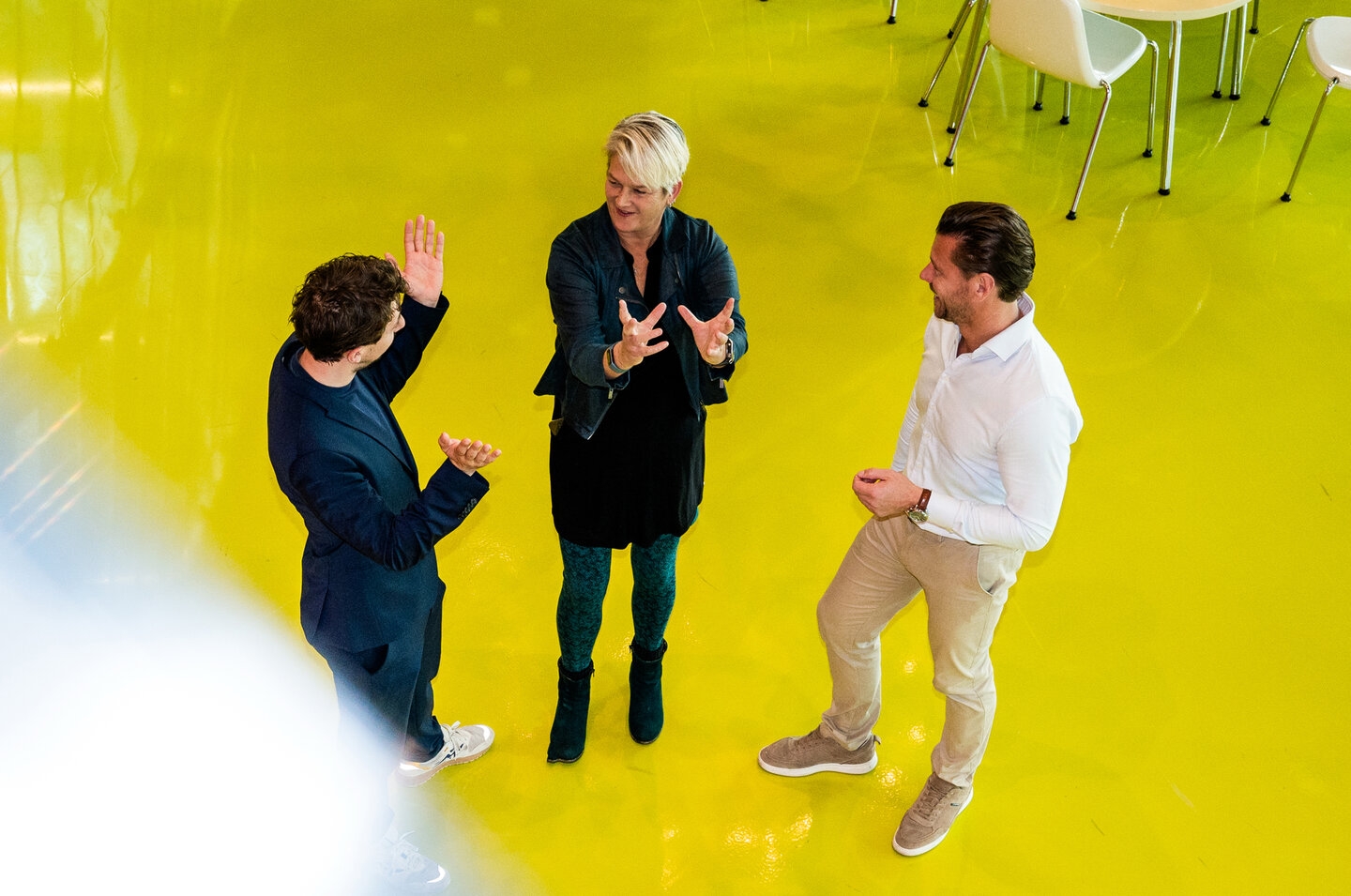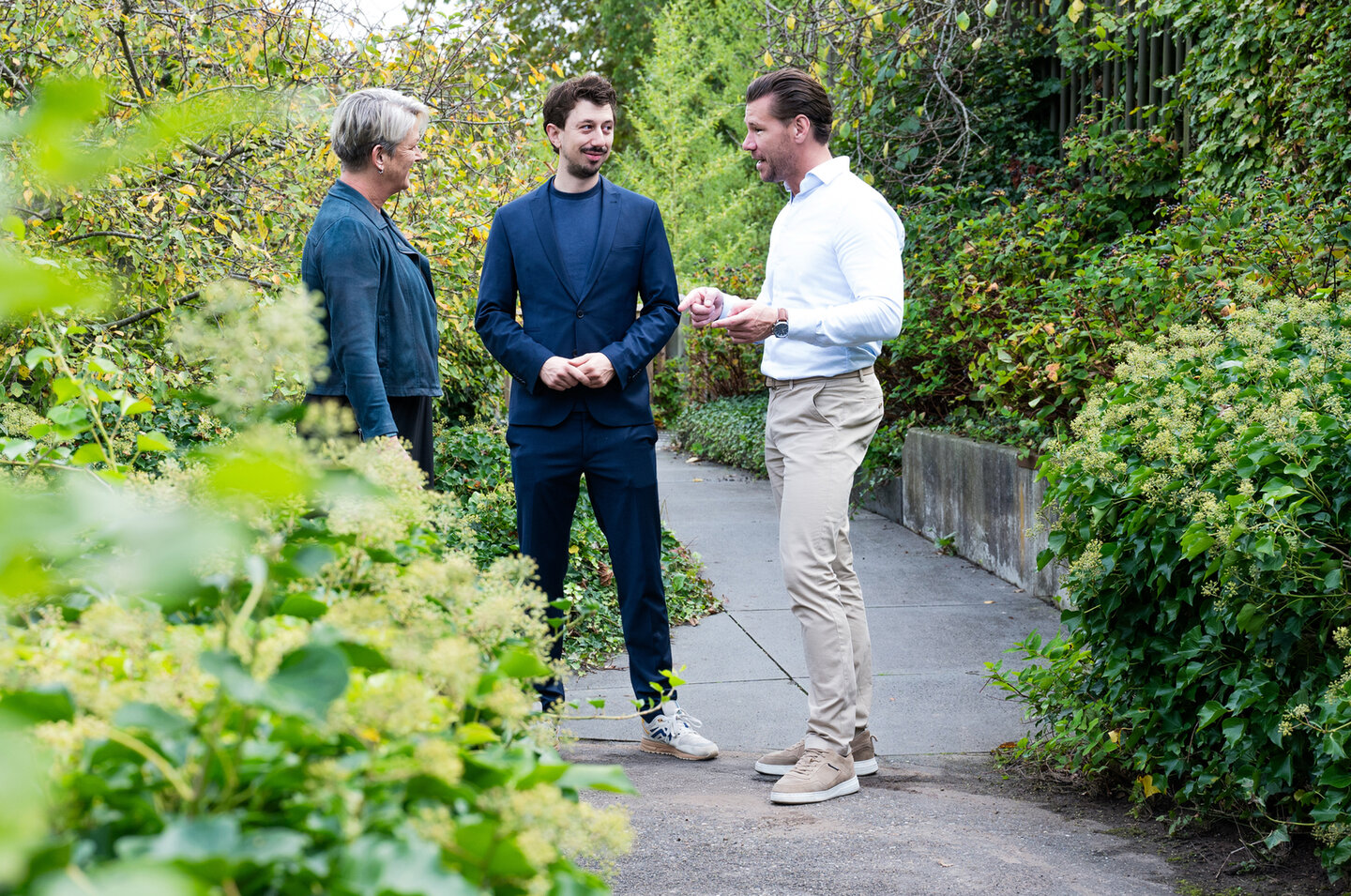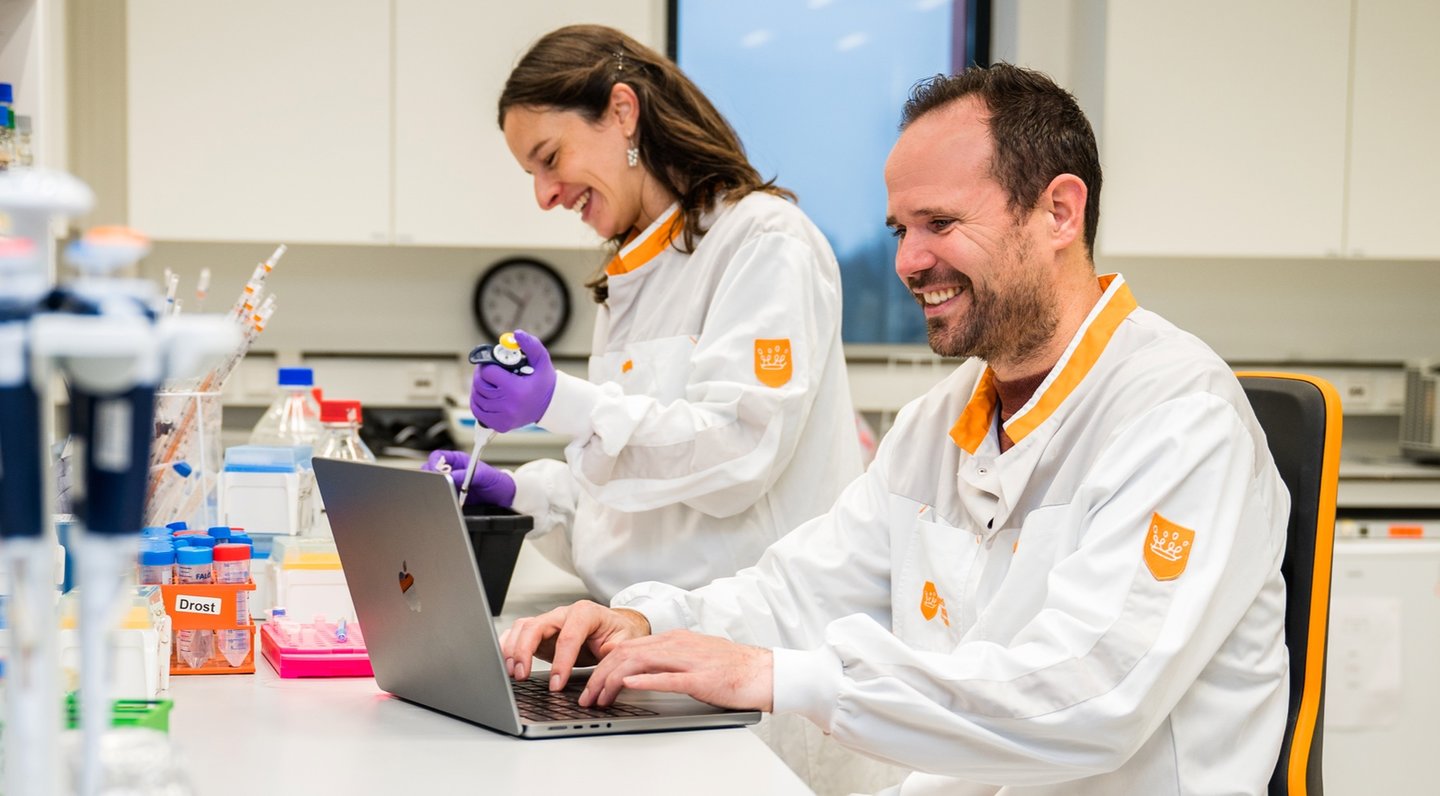Dual Interview
08
Launching a New Therapy for Childhood Cancer: A Look Behind the Scenes
In this interview, Tony Hickson and Jan Paul Medema share their insights on advancing oncology through collaboration.
Developing a new cancer therapy is a complex undertaking. To bring a novel drug to the clinic, top-notch research is essential – but is not enough on its own. Developing and launching a new therapy also requires sufficient funding, an entrepreneurial mindset, and perseverance. In this article, we dive into a story that is still unfolding, with research that began in academia and is now under development towards becoming a new treatment for neuroblastoma, a childhood cancer. We spoke to both the scientists behind the research – Professor Jeanette Leusen and Dr. Mitchell Evers of UMC Utrecht – as well as Rik Leunis of Villa Joep, a funder that made it possible.
Mitchell: “From a scientific perspective, neuroblastoma is a very special type of cancer. It doesn’t come from mature cells, but rather from neural crest cells. Neural crest cells are important during embryonic development, and as you age, they turn into cells that form important body parts like the adrenal gland and neurons of the parasympathetic nervous system. Neural crest cells need to multiply a lot to lay the groundwork for these body parts, and if certain errors are made as they multiply, this can lead to cancer: neuroblastoma. By adulthood, there are no neural crest cells left – they’ve transformed into other cell types. But children still have these cells. That’s why we see neuroblastoma in children – typically in the adrenal gland, above the kidney, or around the spinal cord.”
Jeanette: “Exactly, and there is often confusion due to the name. Neuroblastoma doesn’t first originate from the brain – although it can metastasize to the brain.”
Rik: “Statistically, neuroblastoma is a rare disease. Only about one in one hundred thousand children are diagnosed with neuroblastoma, but the mortality is high. Even though only 6 to 10 percent of pediatric cancer cases are neuroblastoma, neuroblastoma is responsible for 15% of all cancer-related deaths among children. Looking at it another way: out of every 10 children with neuroblastoma, unfortunately only 4 survive. Ideally, we want to eradicate this disease – and at the least, we want to see the survival rate increasing closer to 80%, which is the overall survival rate across all pediatric cancers.”
We have engineered many different antibodies for different reasons — but neuroblastoma was a particularly interesting disease indication.
Jeanette Leusen, Full Professor antibody therapy at UMC Utrecht
Rik: “I have been working with Villa Joep for 7 years. This was driven by our daughter being in treatment. We had a little girl who counted on us as parents to protect her… And then everything collapsed under us. She was three when she was diagnosed. Where I used to feel as her strong dad, I suddenly felt completely powerless. One way to get back my grip on reality was to try to understand as much as possible, and to find out what I could do. That gave me at least a sense of control. I am extremely proud that our daughter is now fifteen years old – a smart, beautiful girl who gets the chance to grow up with the wish to become a doctor herself. But many of the kids we got to know while we were in hospital for her treatment are no longer here. That motivates me to continue working with Villa Joep – which is named after Joep, who passed away from neuroblastoma when he was only four. In his last moments, his parents promised him that they wouldn’t stop searching for a cure for neuroblastoma. Currently, I coordinate Villa Joep’s research team.”
Jeanette: “My group at the Center for Translational Immunology is made up of about 25 people who are all working on antibodies one way or another. Our main interest is IgA – one of the five types of antibodies. We have many different research lines, and one focus area is antibodies as a therapeutic modality for cancer.”
IgA
IgA is one of five main types of antibodies. In the context of oncology, antibodies can function as a sort of power adaptor between cancer and the immune system: they can help the immune system “plug into” cancer. By physically connecting different players in the immune system with tumor cells, antibodies can direct the immune system to mount an anti-cancer attack. The five different types of “power adaptors” – IgA, IgG, IgM, IgE, and IgD – all have slightly different ways of working. For example, IgA is particularly good at directing immune cells called neutrophils to attack tumor cells.

Mitchell Evers, Jeanette van Leusen, Rik Leunis
Jeanette: “We have engineered many different antibodies for different reasons — but neuroblastoma was a particularly interesting disease indication. When we started this research there was a newly available antibody-based immunotherapy for neuroblastoma, Dinutuximab. The discovery of this antibody has led to improvements in the survival of neuroblastoma patients, but it had severe side effects, including neuropathic pain. Based on our antibody engineering expertise, we hypothesized that by adapting the IgG-based antibody into an IgA format we might be able to create a therapy that would have even better anti-tumor action, but without the associated pain of the existing therapy.”
Mitchell: “Based on existing literature and our own early experiments, we knew that the neuropathic pain side effect with Dinutuximab was driven by an arm of the immune system called complement. As we kept working, the evidence started to pile up more and more in favor of engineering an IgA antibody for neuroblastoma. There were two key parts to our plan: we wanted to make an antibody that could activate neutrophils – the most abundant type of immune cell that can kill tumor cells very well in combination with IgA– and we didn’t want to see complement activation. Once we engineered an IgA version of Dinutuximab, it did exactly what we wanted it to do.”
Jeanette: “That was the grounds for our initial grant application to Villa Joep: that we could produce an antibody that triggered neutrophils to kill tumor cells efficiently, with no complement activation.”
Rik: “It was very interesting for Villa Joep because it was a new and different approach. Jeanette and Mitchell could show that their IgA-based molecule was better at reaching tumors, and once it reached the cancer cells it also had an improved mechanism for killing them versus the existing therapy. That was very important, but there was more. Let’s not forget: when it comes to neuropathic pain, many people might say, ‘what is a bit of pain when you’re treating life-threatening cancer in a child?’ But many children have had to stop immunotherapy because of unbearable pain. I remember sitting next to my daughter’s bed while she was being treated, and watching as she kept pushing the morphine button. That was difficult to see. There were nights when it was really painful for her — but consider the fact that she’s actually one of the children who tolerated it relatively well. Imagine what it means for children that tolerate it less. Overcoming this side effect is crucial, and that is solved by Jeanette and Mitchell’s antibody.”
Jeanette: “But we still had to convince people that complement activation was the reason behind the neuropathic pain — and that was difficult!”
Mitchell: “People really didn’t believe us at first. It was almost like blasphemy initially – the reviewers for our first publication of this research said ‘that can’t be true’. They didn’t believe that complement was important.”
Jeanette: “To prove it, we performed animal experiments in collaboration with Professor Niels Eijkelkamp from UMC Utrecht, who is an expert in pain research. We were able to show that animals treated with the existing neuroblastoma therapy, Dinutuximab, experienced pain, whereas with our IgA-based molecule they did not. With these powerful data, we knew this was something we should move forward to the clinic. It could be a solution for many patients – for neuroblastoma but also for other indications. I knew from experience that the first thing we had to do to be successful was to protect our idea. Therefore, we had a conversation with the Holdings, the tech transfer office of Utrecht University and UMC Utrecht, and with a patent attorney. For a successful patent, you need to have an invention that is novel but also has an inventive step – it must not be obvious to experts in the field. And for that reason, it was actually beneficial that nobody believed the complement story – it was clear that it was something new and unexpected!”

Jeanette van Leusen, Mitchell Evers, Rik Leunis
Mitchell: “Making the next step towards the clinic was one of the most challenging parts.”
Jeanette: “Yes, once we had our patents, we approached companies, presented our novel data, and asked if they would like to license the antibody and bring it to the market. They all thought it was very interesting, but asked us to first do phase one and two clinical trials — which cost millions of euros. That is too expensive for an academic group like ours. The other solution was to start our own company and find investors. So that’s what we did. We founded TigaTx together with Mark de Boer, a serial entrepreneur, in 2018. In 2020 we got the first seed investment of $12 million. That was enough to validate our findings and initiate safety studies.”
Rik: “As funders, this is exactly what we want to see happening! We need new, innovative therapies to be industrialized and not just be left in a lab. We understand the need for patenting and commercialization – it’s part of the game in getting a therapy to the clinic.”
Jeanette: “At TigaTx, they concluded that neuroblastoma was too small of an indication to start with – there are so few patients. From an investor point of view that makes sense, but as a researcher and seeing the medical need in neuroblastoma, I was rather disappointed. They chose to first go forward with a larger indication of solid tumors in adults. At the end of 2024 they got grants of $35 million and now the large clinical batch production of engineered IgA can start and the start of clinical trials is planned for 2026. That’s already a big step: it will be the first time that an IgA-based therapeutic is given to patients, and we will see whether it is safe to treat humans with this novel isotype. If so, it will also pave the way for development of IgA-based therapies for neuroblastoma. And we’re still working on IgA-based therapies for neuroblastoma here at the UMC Utrecht, and within Oncode Accelerator.”
Our work changed the whole paradigm in the field. I hope that other people also use this idea to develop other therapies that could be beneficial for patients in the future.
Mitchell Evers, Assistant Professor at UMC Utrecht

Jarno Drost
Mitchell: “We have a good biological understanding of neuroblastoma, we have the beauty of IgA, and this important side effect that could be solved by using it. It is such a beautiful investigational drug for this indication. So now we are working on advancing next-generation IgA molecules within Oncode Accelerator. We have two different concepts that we want to advance and bring towards the clinic. One of our ideas is to take away the biological brakes on IgA, to activate different types of immune cells against neuroblastoma. The other thing we’re working on is developing bispecific antibodies, where each of the two arms of the antibody grab on to different receptors. Using this approach, we can design antibodies to harness the immune system in smarter, more precise ways to attack cancer cells.”
Rik: “This work may seem far away from the patient, but everything that is used in the clinic now was once fundamental research. So even if research is very fundamental or early, it can hold a lot of promise for the future. Outcomes are not always certain — but that’s science. Villa Joep is focused on getting new therapies to the clinic fast, but we know that it all starts with fundamental, molecular research – that’s cornerstone of the novel therapies being developed.”
Mitchell: “For us, working with Villa Joep was motivational. With Villa Joep, you don’t just get a letter that your award is granted. People from the organization came and visited the lab, and told us that they were excited to see our work move forward. That’s very touching.”
Rik: “At Villa Joep, we are a small team representing a small group of families. We’re close, and we try to connect and inform parents. At time the time of diagnosis, many of us don’t even know what neuroblastoma is. So information is important, but so is building connections with doctors and researchers. These are not just people with microscopes and computers who do their day jobs and then go home. They are typically really passionate about what they do. And that’s what you hear in this story. It’s what makes them part of our Villa Joep family”
Jeanette: “That’s what I also liked about Villa Joep: it’s personal. You speak directly, in-person with the funders. They visited us at the UMC Utrecht, and shared personal stories of Joep and other patients. The patient perspective never came so close for me before; it even got emotional for me. You really build a connection.”
We need new, innovative therapies to be industrialized and not just be left in a lab. We understand the need for patenting and commercialization – it’s part of the game in getting a therapy to the clinic.
Rik Leunis, coordinator Research Department at Stichting Villa Joep
Mitchell: “For me, one of the best moments from this project was when a colleague sent us a photo from a neuroblastoma conference where other researchers were using our figure to explain how complement activation was the mechanism behind the neuropathic pain side effect of Dinutuximab. We had to fight so hard to show that avoiding complement activation was a way to reduce that side effect. Our work changed the whole paradigm in the field. It was really nice to see that people at the conference believed and used our work. I hope that other people also use this idea to develop other therapies that could be beneficial for patients in the future. On top of that, antibody engineering has come such a long way over the last ten years. If you understand disease biology well and tailor your antibodies as beautifully as you can to improve efficacy and reduce treatment resistance, I think it can now do things that we wouldn’t have thought were possible before. We can really make a difference for patients here.”
Rik: “The passion of people will bring us forward. Here you see two researchers showing so much passion for the work they do, and with the endgame in mind. And the same goes for Villa Joep: we’re a group of volunteers who are so passionate and have achieved so much. We’ve raised more than €18 million for research, and every euro we get goes to neuroblastoma research – we don’t have any costs as an organization. With a group of passionate people, you can achieve so much.”
Jeanette: “It’s also about perseverance. My message is: keep on pushing! When you know you have a good idea, don’t let it go. Continue working on it and don’t stop until you reach your goal. And in this case, my goal is: get it in the clinic!”
About
Mitchell Evers
University Medical Center Utrecht, Program Manager Biologics Workstream
Mitchell Evers is an antibody scientist with experience in preclinical development of biologics across academia and industry. After obtaining a PhD in antibody therapy in the lab of Professor Jeanette Leusen at UMC Utrecht, he built on his doctoral research as a Scientist at the spin-off company TigaTx, which develops engineered monoclonal IgA to potently activate neutrophils, for the treatment of cancer, and overcome historical challenges associated with the developability and functional properties of IgA. Currently, Mitchell is an Assistant Professor at UMC Utrecht and Program Manager for the Biologics Workstream within Oncode Accelerator, where he applies his knowledge in developing academic discoveries towards clinical applications.
About
Jeanette Leusen
University Medical Center Utrecht, Biologics Workstream Lead
Jeanette Leusen is a full professor antibody therapy in the Center of Translational Immunology (CTI) of the University Medical Center in Utrecht. Her group focuses on the mechanism of action of natural and therapeutic antibodies, with a special interest in IgA as a novel class of antibody for the treatment of both malignant as infectious disease. She is heading the UMAB facility, founded in 2012, and is scientific founder of TigaTx, a spin-off company on engineered IgA as therapeutic antibody in oncology. She is inventor of > 10 patents. Jeanette is co-lead of the Biologics workstream within Oncode Accelerator.
About
Rik Leunis
Coordinator Research Department at Stichting Villa Joep
Rik Leunis coordinates the Research Department at Stichting Villa Joep, overseeing scientific grant proposals and monitoring neuroblastoma research progress. Rik also has an extensive career at The Goodyear Tire & Rubber Company mostly in sales related roles, currently serving as the Director Revenue Management Consumer EMEA since 2022. Rik holds a degree in Economics, Management, and Marketing from IVA Driebergen and a NIMA-B qualification in Strategic Marketing Planning.
Credits: interview by Iris Gombert and Peter Thijssen; photography by Marloes Verweij, Laloes Fotografie